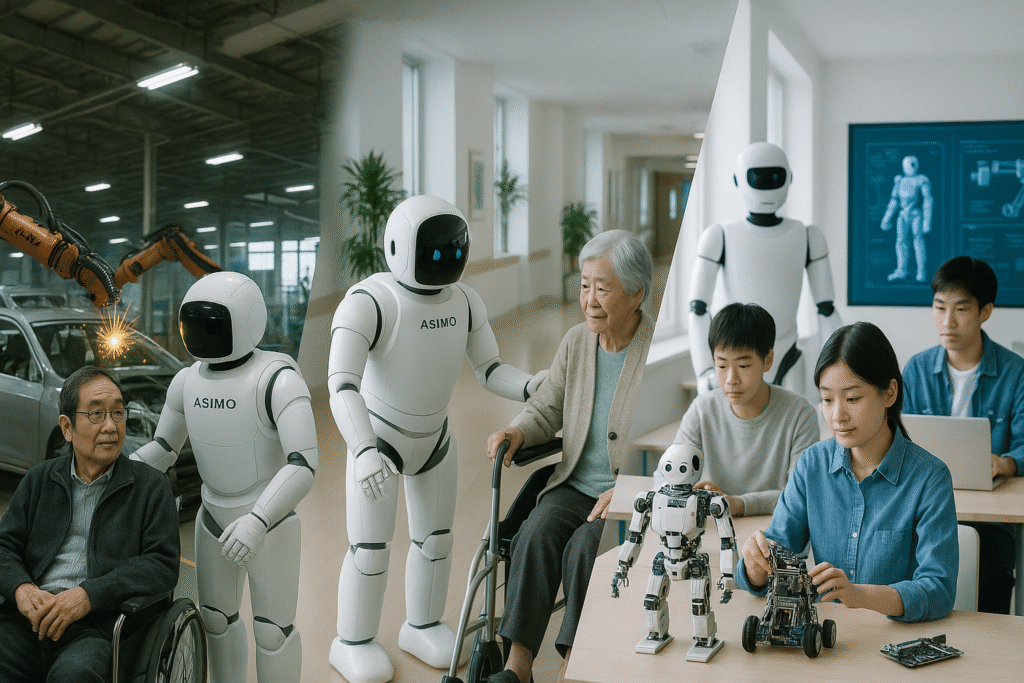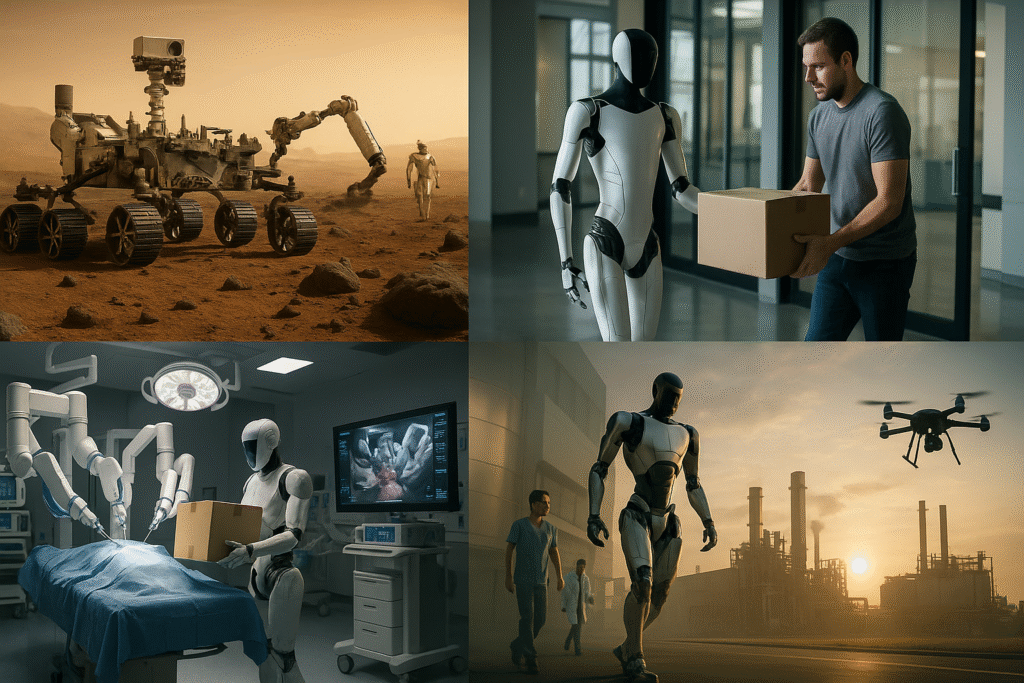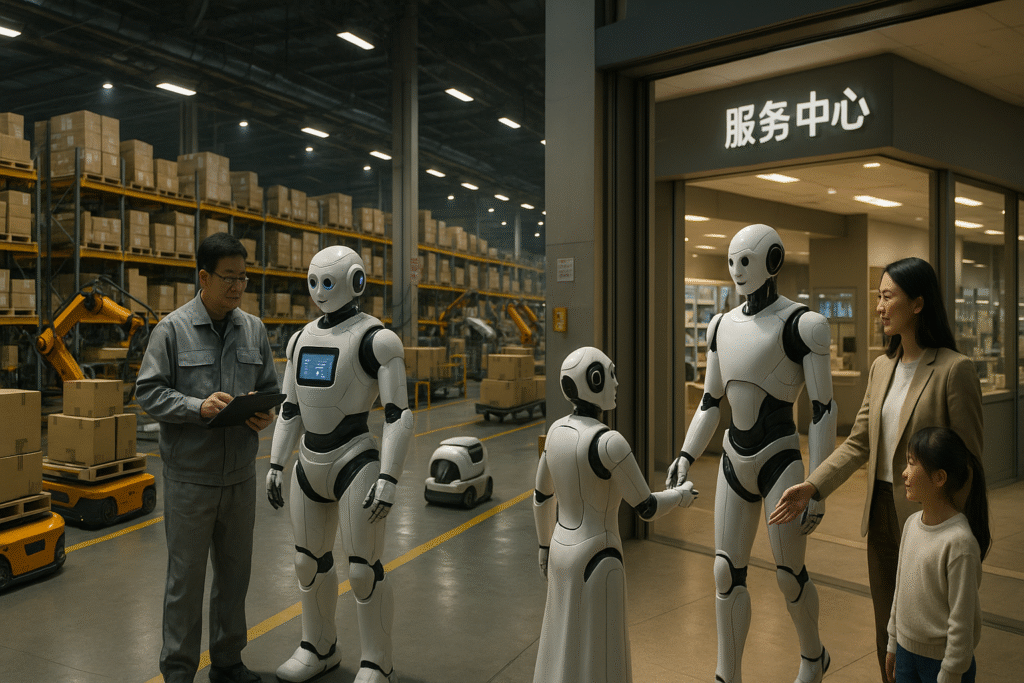The future of robotics and artificial intelligence (AI) is changing every part of the world in big ways. Japan, the US, China, and India are all using their own unique methods to change the way things are done in healthcare, agriculture, defense, and everyday life.
We will talk about the past, the present (2025), the costs, the functions, the benefits, the challenges, and the plans for the future (2040+) of robotics in these countries in this blog.
Japan: Robotics Leader (1970s–2040)

The 1970s saw FANUC, Kawasaki, and Honda start making industrial robots in Japan. These robots made industry faster and more accurate. Humanoid robots like ASIMO, Lovot, and Pepper were created in Japan later on and are used to care for the elderly, teach, and connect with other people. These new advances demonstrate that the future of robotics lies in creating advanced industrial and humanoid solutions.
Cost and Functions
- Industrial Robots ($100,000 – $500,000 per unit): Welding, painting, assembly, material handling, quality inspection
- Humanoid Robots ($50,000 – $200,000 per unit): Elderly care, education, hospital assistance, customer service, social interaction
- AI & IoT Integration ($20,000 – $50,000 per system): Predictive maintenance, smart decision-making, data analysis, remote monitoring
Japan in 2025
- Factories employ advanced robots for welding, assembly, and painting
- Service and healthcare humanoid robots assist staff and patients in hospitals and elder care centers
- Educational institutions offer robotics and AI programs, providing students with practical STEM learning
Benefits:
- Productivity & Accuracy: Faster manufacturing and improved quality control
- Safety & Human Assistance: Protects humans from hazardous tasks and supports elderly care
- Innovation & Education: Leadership in robotics education and STEM skill development
Future Vision (2025–2040+):
- 2025: Industrial automation becomes widespread
- 2030: Service and healthcare robots become common
- 2040: Household humanoid robots are integrated
- Beyond 2040: Smart homes, disaster response, and space exploration
USA: Robotics Pioneer (1954–2040)

Unimate started modern robotics in the United States in 1954. NASA’s Mars rovers and space exploration robots made a big difference in the field of robotics research. Boston Dynamics (Atlas, Spot) and Tesla Robotics (Optimus) are two companies that are making humanoid robots with AI built in. These robots will change the future of robotics in space, healthcare, and industry.
Cost and Functions
- Industrial Robots ($120,000 – $600,000 per unit): High-precision manufacturing, assembly, material handling
- Humanoid Robots ($60,000 – $250,000 per unit): Healthcare support, customer service, educational assistance
- AI & IoT Integration ($25,000 – $60,000 per system): Predictive maintenance, smart operations, real-time monitoring
USA in 2025
- Factories use industrial robots for high-precision manufacturing
- Surgical robots and hospital assistants support patient care and staff
- Defense sector employs autonomous drones and bomb disposal robots
Benefits:
- Productivity & Innovation: Industrial automation, R&D efficiency, space exploration
- Safety & Healthcare: Reduces human risk in dangerous missions, surgical support
- Education & Technology: Leadership in robotics education and AI research
Future Vision (2025–2040+):
- 2025: Expansion of industrial and space robotics
- 2030: Humanoid robots in hospitals and service sectors
- 2040: AI-integrated humanoids in everyday life
- Beyond 2040: Fully autonomous smart homes
China: Manufacturing & AI Robotics Powerhouse (1990s–2040)

China began industrial automation in the 1990s, rapidly expanding mass production of industrial and AI robots. Companies like DJI, Siasun Robotics, and Huawei are competing globally in the robotics market, leading the future of robotics in mass production, logistics, and healthcare automation.
Cost and Functions
- Industrial Robots ($80,000 – $400,000 per unit): Mass production, assembly, warehouse automation
- Humanoid Robots ($40,000 – $150,000 per unit): Healthcare support, logistics, customer interaction
- AI & IoT Integration ($15,000 – $40,000 per system): Data-driven automation, predictive maintenance, smart operations
China in 2025
- Factories are highly automated
- AI-powered service robots operate in warehouses and hospitals
- Robotics improve efficiency in logistics and healthcare
Benefits:
- Industrial Productivity: Mass production and reduced errors
- Healthcare & Public Services: Medical assistance, delivery, sanitation
- Innovation & Technology: AI integration, IoT-enabled robotics
Future Vision (2025–2040+):
- 2025: Industrial automation widespread
- 2030: AI-powered logistics and healthcare robots become common
- 2040: Household robots integrated
- Beyond 2040: Smart homes, disaster response, and fully automated public services
India: Emerging Force in Robotics & AI (1980s–2040)

India started robotics research in the 1980s via IITs and DRDO. Industry and startups like GreyOrange, Invento Robotics, and Asimov Robotics are advancing industrial, healthcare, and agricultural robotics, shaping the future of robotics in emerging markets.
Cost and Functions
- Industrial Robots ($50,000 – $200,000 per unit): Warehousing, assembly, logistics
- Humanoid Robots ($25,000 – $100,000 per unit): Healthcare, education, service tasks
- AI & IoT Integration ($10,000 – $30,000 per system): Smart farming, predictive maintenance, remote monitoring
India in 2025
- Industrial, healthcare, and agriculture robotics adoption is growing rapidly
- Humanoid robots assist hospitals, warehouses, and farms
- AI-powered drones and robots optimize precision farming for irrigation, seeding, and crop monitoring
Benefits:
- Faster manufacturing and optimized logistics
- Safety in dangerous tasks, surgical support, and elder care
- Growth in robotics and AI research, and startup ecosystem
Future Vision (2025–2040+):
- 2025: Expansion in industrial, healthcare, and agriculture robotics
- 2030: Smart cities deploy robots for security, cleaning, and traffic management
- 2040: Household humanoid robots assist with personal care
- Beyond 2040: Fully integrated AI-powered smart homes and disaster response systems
Conclusion: The Transformative Impact of the Future of Robotics Worldwide

The future of robotics is changing homes, communities, and businesses all across the world. Japan, the United States, China, and India are all working to make productivity, safety, healthcare, and education better. Building robots costs a lot of money, but the benefits in the long run are huge. By 2025 to 2040, humanoid robots and AI-integrated systems will be necessary in homes, offices, and public places. This will make it possible for people and machines to work together in a way that is sustainable, efficient, and collaborative.
“The Future of Robotics is reshaping industries and redefining everyday life.”
👉 Join Our Facebook Page : Join Now
👉 Join Our Instagram Page :- Join Now